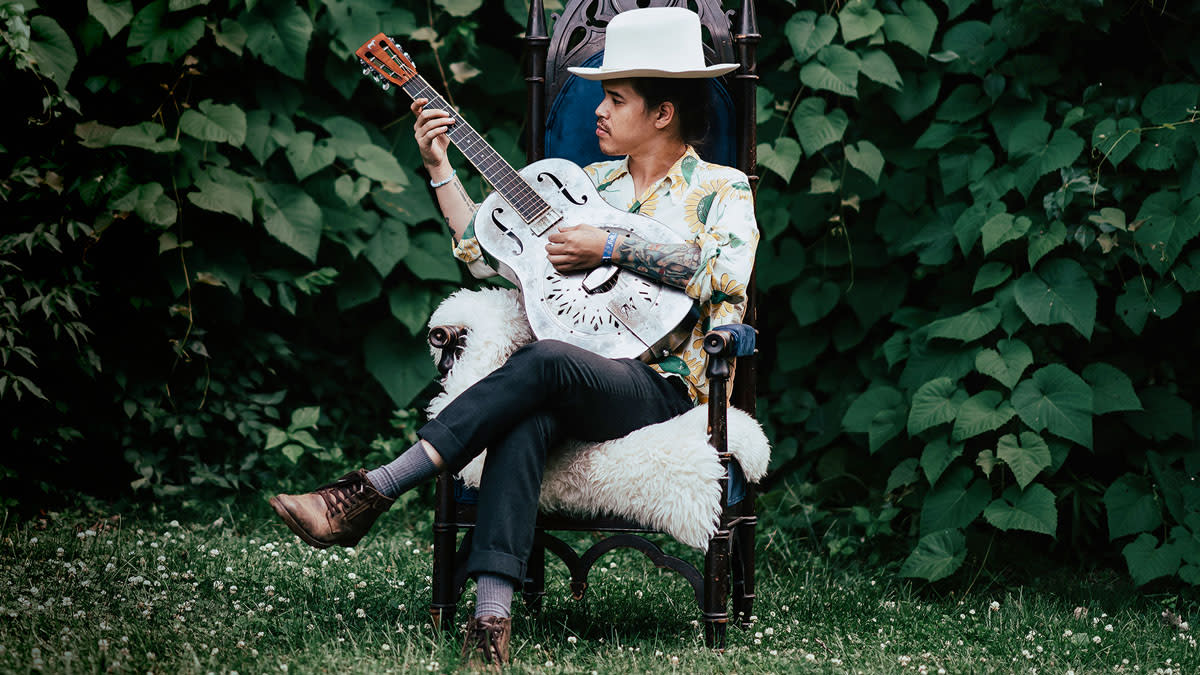“People tell me my big mistake was not learning guitar right-handed... No, my big mistake was not learning guitar upside-down!” Meet Nat Myers, the Dan Auerbach protégé updating rootsy blues for the post-pandemic era

- Oops!Something went wrong.Please try again later.
When Nat Myers received an email out of the blue from a man claiming to be the studio manager for Dan Auerbach’s Easy Eye Sound record label, he assumed it was spam and almost deleted it.
It’s a good thing his curiosity got the better of him, because the offer contained in that email – to come to Nashville and “lay a record down that you can be proud of” – turned out to be entirely legit, and resulted in the making of Nat’s impressive country blues debut, Yellow Peril.
“It was very serendipitous,” recalls the Korean-American bluesman, whose musical career up to that point had largely consisted of busking on the streets of New York, playing “for tips gigs” at the Jalopy Theater and sharing homemade recordings of his songs online.
“I had heard of Easy Eye Sound before,” he says, “because I’ve listened to a lot of Sharecropper’s Son by Robert Finley and I really like that record.” But he wasn’t even looking for a record deal at the time, let alone a deal with one of the most respected guitarists-come-producers working in roots-based music today.
“It was very trippy, kind of like a David Lynchian daydream,” he says, reflecting on the surreal experience of entering Auerbach’s studio for the first time, where he would later return to collaborate with the Black Keys star himself, plus Nashville songwriting supremo Pat McLaughlin and country blues torchbearer Alvin Youngblood Hart.
“It’s like a Black Lodge, but [with] good vibes,” Nat laughs. “They’ve got a little round table out the back and we just shot the shit, talking about the blues. That’s how it got going.”
Like Auerbach, Myers is a repository of knowledge when it comes to traditional styles, and studying the likes of Robert Petway, Elizabeth Cotten, Tommy McClennan and Memphis Minnie has profoundly shaped his authentic brand of pickin’ and storytellin’. His specialism is the Piedmont style, where the thumb holds down an alternating bass pattern on the lower strings and the index and middle fingers pluck syncopated melody lines on top.
To this, he adds frenetic slide playing à la Charley Patton and allows himself to drag on the beat just enough to evoke the spirit of the Mississippi Hill Country masters – altogether successfully swerving “the hokeyness that’s associated with preservation”, as he terms it.
“When it comes to how I’ve learned, it’s a lot of watching and a lot of closing my eyes after and really meditating on those songs,” explains the highly skilled self-accompanist, who considers himself “self-taught to the extent you can be in the 21st century”.
I got this guitar through really deep friendships I’ve forged and I thought it was only right that I cut my first record on it
At just 32 years old, his life experiences are, of course, worlds apart from the musicians he looks to for inspiration. But, if it weren’t for the lyrical content, which anchors Yellow Peril squarely in modern times (its title track refers to the appalling rise in Asian hate that occurred during the Coronavirus pandemic), you could be forgiven for thinking Myers’ debut was a remastered field recording from a bygone time.
This is partly because, when the time came to record, the whole crew decamped from Easy Eye HQ and set up a makeshift studio at Auerbach’s century-old Nashville home, capturing ambient background noise and Myers’ foot stomp on the hardwood floor as well as his guitar and vocal parts.
Recorded direct to tape, he cut all 10 tracks in three days, using only one guitar: a steel tricone resonator made by Matt Eich of Mule Resophonic. Auerbach contributed slide to Undertaker Blues using a 1935-1940 brass-bodied Dobro, which Nat describes as having had “the most peculiar sound” – one he likens to the trumpet playing of W.C. Handy.
Reaching for the instrument we hear the most on Yellow Peril, he tells us: “I got this guitar through really deep friendships I’ve forged and I thought it was only right that I cut my first record on it.”
Being a left-handed player, Myers also finds the vintage reso market “very limited,” so having access to a masterfully built modern instrument with an old-time feel seems like an apt solution for the kind of artist he is.
“People often tell me that my big mistake was not learning guitar right-handed,” he smiles. “But I counter them and say, ‘No, my big mistake was not learning guitar upside-down!’”
Yellow Peril is out now via Easy Eye Sound.

